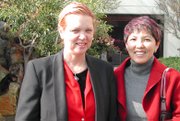Pitching Technology to L.A.'s Melting Pot
Bringing technology to the melting pot that makes up the Southern California garment industry can be a cumbersome task, but design-software firm PAD System Technologies said it has a secret weapon.
Shelly Chan is the company’s Los Angeles-based agent/distributor, multitasking problem solver and “secret weapon.” She has assisted the company in capturing more than 500 U.S. accounts. She’s also been instrumental in helping PAD eliminate the barriers between technology and the region’s sometimes insular apparel industry with its ethnically and culturally diverse population.
It helps that Chan speaks fluent Chinese, Korean and English, but her abilities go beyond language skills, said Kristine Gloviak, PAD’s U.S. director.
“She’s our troubleshooter,”said Gloviak. “Whenever there’s a problem, maybe a competitor trying to lure away business, we send her in.”
Chan has been able to mix especially well into Los Angeles’ communities of Korean and Chinese apparel workers. She is Chinese and grew up in Korea, which has helped her understand different work environments and ways of doing business. As the local apparel industry continues to boost its sourcing in Asia, such understanding becomes more important than ever, said Gloviak.
Chan has also worked in almost every aspect of apparel manufacturing. She is a graduate of the Fashion Institute of Design & Merchandising. She’s been an assistant designer and patternmaker and has done it all––from pushing garment baskets to cutting and sewing.
“I just wanted to work in the apparel business,” she said. “I would do anything and ask for any job.”
In her current position with PAD, she has learned that when communicating with manufacturers, you can’t always take the hard-sell route.
“You can’t oversell in this market,” she explained. “It’s difficult to get your foot through the door. There are different work environments and different atmospheres. You take it step by step. Sometimes I just go say ’hi’ to these companies.”
Chan said PAD’s icon-based pattern-making and design systems have helped penetrate language and cultural barriers.
“I think our system goes beyond the usual icons in that they are more explanatory,” she said. “For example, the icon we have for scissors looks like something that is separating a garment. You really get an idea of what it’s doing.”
Gloviak said the company’s 3D tools also enhance visual presentations, which simplifies users’ transitions from other systems and makes it easy for CAD/CAM users to learn the software. PAD uses Alias/Wavefront’s Maya software, which has been touted as one of the best lifelike software products on the market. PAD users can export patterns in Maya’s ASCII format to be assembled in PAD’s Haute Couture 3D module in two clicks.
The Maya combination has attracted customers such as Pixar Studios, which has been using it to create garments for its animated characters. Apparel-related technology companies, such as My Virtual Model, have also been using it.
The company regularly trains users in Spanish, Korean, Chinese and English at its offices in the California Market Center.Despite the progress, Chan and Gloviak said that they see further challenges as only half of garment makers use automated systems. In addition, they see local users under-utilizing the technology they have.
“In Asia, we see patternmakers and designers using 90 percent of the capabilities of the software, but here it is only like 25 to 50 percent,” said Gloviak. “We’re trying to change that.”






















